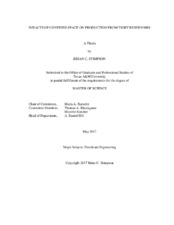| dc.description.abstract | This work develops a rigorous method for including confinement effects in fluid modeling. This method was implemented into phase modeling and compositional reservoir simulation to show the impacts of tight media on hydrocarbon phase behavior and production. The rigorous aspect of this method improves upon current methods of incorporating confinement effects in both fluid modeling and reservoir simulation. It is particularly useful for porous media with small pores, where the ratio of medium surface area to fluid volume and fluid-to-rock interaction are significant.
The proposed model utilizes the Peng-Robinson equation of state coupled with the Young-Laplace equation for capillary pressure. The interfacial tension is determined using the parachor model, which is dependent on phase compositions and molar volumes. Capillary pressure is therefore implemented within the vapor-liquid equilibrium (VLE) calculations. Contact angle is an input and can be updated as a temperature-dependent function. When implemented inside the VLE loop, calculation time is minimally impacted, making this a very efficient method.
Vapor-liquid equilibrium using this method for small pores is validated by modeling cases presented in published literature. These published data are obtained either experimentally or by using molecular simulation. In all cases, the model presented in this work is able to closely match phase behavior, showing a decrease in bubble point pressure, and an increase in dew point pressure. Changes in saturation pressure approach zero as the mixture critical point is approached.
Implementation of this method into compositional reservoir simulation shows that confinement generally increases oil and gas production from tight oil reservoirs and generally decreases oil and gas production from tight gas condensate reservoirs, compared with the traditional bulk compositional simulators.
Simple cases of a reservoir cell can be modeled with capillary pressure using a constant-composition expansion or constant-volume depletion method. This results in a capillary pressure curve as a function of liquid saturation. With these curves, relative permeability can be predicted by integration of the reciprocal of the square of capillary pressure.
Reservoir simulation of an Eagle Ford reservoir fluid at various initial pressures shows the impact of capillary pressure and relative permeability on production. At high initial reservoir pressure, oil/gas relative permeability is insignificant, but capillary pressure still significantly impacts oil production. At lower initial pressure, capillary pressure and oil/gas relative permeability both significantly impact production. | en |


